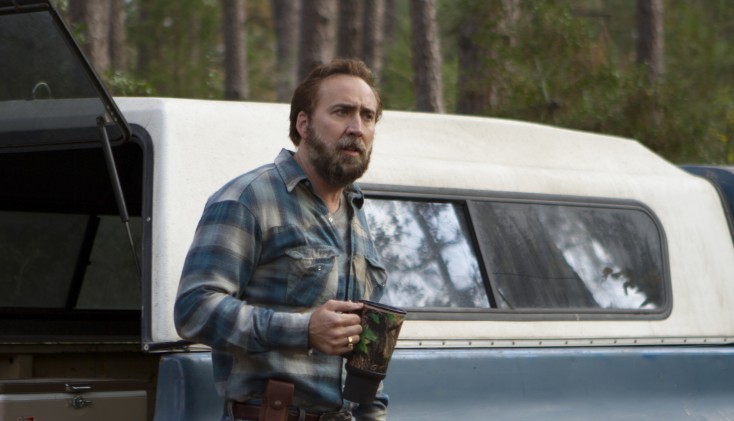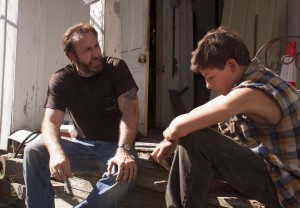By ANGELA DAWSON
Front Row Features
HOLLYWOOD—No matter what your feelings are towards Nicolas Cage as an actor, you can always expect an interesting, unique, if not utterly outrageous, experience interviewing him. The maverick performer, known for his intense, sometimes over-the-top performances and real life foibles, has a book’s worth of titillating anecdotes, and he always delivers some new gem about his life and his views on his profession.
The peripatetic actor now stars in the Southern drama “Joe,” based on the popular Larry Brown novel, about an ex-con, who is trying to dodge his instincts for trouble and his abhorrence of authority, until he meets a hard-luck kid, who awakens in him a fierce and tenderhearted protector.
The thrice-married actor, who got his start in the early ‘80s with “Fast Times at Ridgemont High” and has continued to work regularly over the next three decades, says he found a sort of kinship in the title character—someone who had made mistakes in his life but who, essentially, was trying to do the right thing. He spent a month working closely with director David Gordon Green (“Pineapple Express,” “Prince Avalanche”) helping scout the locations, something almost unheard of among actors of his stature. He spoke about working with Green, and his young co-star Tye Sheridan, and how Bruce Lee and Haagen-Dazs vanilla ice cream informed his performance.
Q: What attracted you to this role and how did the project come to you?
Cage: The project came together because David wrote me a great letter and expressed his interest in doing the movie with me. I read the script. I immediately connected with the character of Joe. Then I read the novel. I read it twice, and then I wanted David to know how enthusiastic I was about it so I went to Texas and walked around a couple of days, had some tacos, and talked about it. I said to him, “I really want to make this movie with you.” Also, I’d been waiting a while to find something. I took a large part of the year off, where I could realize some of my film performance dreams. I’d experimented with more abstract, or what I call “Western Kabuki” or baroque-style film performance, and some of the more adventure films that I’d done. I was at the point where I just wanted to just find a part where I didn’t design the performance. I just felt it or could just be in it. Whatever mistakes I’d made in the past, which I won’t go into detail with, I wanted to put them into a character, a portrayal of understanding, and use the mistakes in a way that I wouldn’t have to act so much.
Q: Joe ends up being this mentor or father figure to Tye’s character, Gary. Was there ever someone who took you under his wing when you were a young actor or thinking about becoming an actor?
Cage: I had a very strong relationship with my actual father, so I’m lucky in that way. But, yeah, there were let’s call them angels in my life who took a liking to me. What does a father really do? My definition of a father is someone who empowers their children. Sometimes, like with Tye’s character, at home that’s not happening. There’s abuse because the child may have more potential than the father, and the father takes it personally and abuses the child. But I have found people in my life—that’s not my situation—but I have found people like my science teacher Mr. Phipps, my drama teacher in high school, John Engel, my kung fu teacher when I was 12, Jim Lau—these are people who see potential and want to encourage potential. This movie, to me, is an ode to those people.
Q: What advice did you receive from your father that you have passed on to your sons?
Cage: I try to give freedom and see where the potential’s going. If it’s drawing, then I make sure we have the best pencils and paints and paper and canvases. If it’s music, then I make sure we have the best instruments so they find their own way. They meet the instrument and start to have that relationship. It’s not about forcing, but about providing.
Q: How do you decide which direction your going to go in a film? Is it the material, the script or the director? How do you decide which way to shape your performance?
Cage: It’s the material. It’s also where I’m at in my life. There has to be a mechanism in the script that would allow me to go into that Western Kabuki, let’s call it, way or baroque way, where it still connects with the audience in a contemporary environment. Like the silent film actors of the 20’s, or German Expressionistic actors like Max Schreck, they could do all that because that was part of the style back then. So I was trying to figure out how to bring that back into contemporary cinema, and the way to do it is to find someone who is either a) going nuts, like Peter Loew in “Vampire’s Kiss” or b) he’s on crack like Terence McDonagh in “The Bad Lieutenant: Port of Call—New Orleans” or c) he sold his soul to the devil and his head goes on fire into a flaming skull and he’s in black leather, and you can be an actual moving tattoo (in “Ghost Rider”), so those were all fun ways to have it still connect with an audience. But again, when I got around to “Joe,” it was like now I need to, and also “Frozen Ground,” now I just want to infuse the vessel of the character with my memories and my life experience, and not design a performance from the outside in. You can go as big as you want as long as it has emotional content. I always say, if you think it’s over the top then tell me where the top is first. I don’t think anyone can. But if you can tell me where the top is then I’ll tell you whether or not I’m over it.
Q: You’ve done a few Hollywood comedies and have moved back into the independent world. Is this kind of refreshing to get out of the Hollywood system? And does it bring more freedom?
Cage: I have to agree, but I think that “Joe” is a unique movie. It’s an original movie and it’s David’s vision and has it’s own voice. I’ve never seen a movie quite like it. But if you look carefully at my filmography, you will see that between the adventure films there have been a “Bad Lieutenant,” a “World Trade Center” or a “Matchstick Men.” I want to keep it eclectic. I see myself as a student. I would never call myself a master or a maestro. If you take the path of the student, that means you have to try a little bit of everything in hopes that you’re going to learn something or strike some kind of new note, expression in the process. I’m not going for grades; I’m going for an education. I’m going to continue experimenting and trying new things to try to evolve and learn.
Q: Whenever I watch David Gordon Green’s movies, I always feel like I’m going to learn about some obscure profession I never knew existed. This time, it was about people who poison trees so they can clear the land.
Cage: My father always used to say to me, it doesn’t matter what the profession is, but if they’re the best in their field, it will always be fascinating to watch.
Q: I know that Larry Brown’s book served as the blueprint for the script, but how much does the character change when you get on set and you see how much that a movie star can bring?
Cage: I wanted to get (to Texas, where the film was shot) early. I wanted to spend a month in advance with David, getting into his process and I really wanted to soak up Austin so by the time we got to “Action,” there was a flow to it. Last night, we had a screening of the movie and it went really well. I was really happy with the response. Then David and I had a Q&A. They asked me if there was anything in the book that I put back into the script. I didn’t answer it, but then this morning I said to David that my answer was going to be all about Haagen-Dazs and Bruce Lee, but I don’t know if they were going to understand it.
Q: So what is the connection?
Cage: In the book, Larry Brown has this very beautifully described scene where Joe is pulling buckshot out of his shoulder. The way it’s described in the scene, he’s holding a bottle of alcohol pressed against his shoulder and the blood is mixing with the alcohol and it’s beautifully described as this pink, foaming thing as he’s pulling it out. I said, “I think we should put that back in the script because I think it speaks volumes about the character.” Now, here we go to Haagen-Dazs and Bruce Lee. My father once came home with a brand new carton of Haagen-Dazs. It was the first time it came out. He said he had this Haagen-Dazs and everyone says it’s the best ice cream in the world. And it was vanilla. He said, “I got vanilla because I want you to know without the complexity of other flavors if they achieved the simplest flavor.” So we tried the vanilla and it was like, “Wow!” It was the best vanilla I ever had. Then my father took me to see “Return of the Dragon,” with Bruce Lee and Chuck Norris. It was the last fight scene in the movie, and Bruce Lee broke Chuck Norris’ arm. And Chuck Norris was in extraordinary pain. Pain is something we’ve all seen and all experienced. We all know when you’re faking it or lying. We know if you’re really feeling it. Pain, of all of the emotions to display, is the vanilla. So Chuck was in pain and my father said, “You really feel the pain in his performance.” So I said to David, “Let’s put Joe pulling out the buckshot out so I can portray the pain— the vanilla—so people will know that I’m totally committed.” So there’s my Haagen-Dazs vanilla ice cream-Bruce Lee-Larry Brown-David Gordon Green-“Joe” story.





